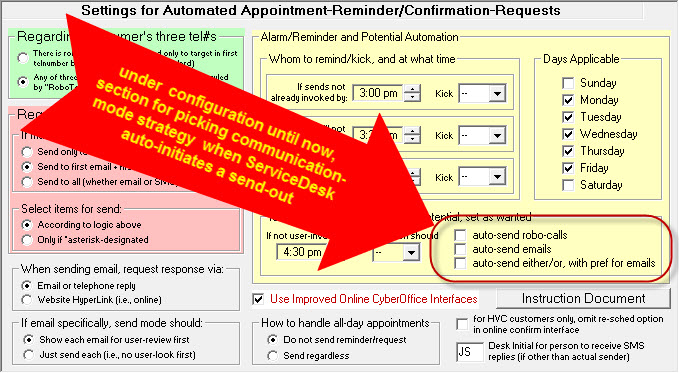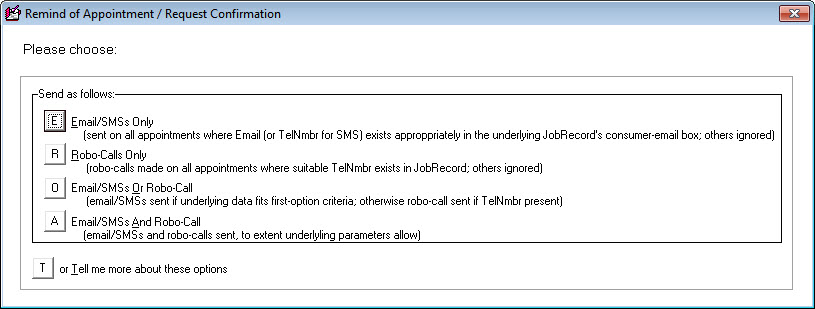ServiceDesk 4.8.206 Update 2/24/21
Automated Assurances to Customers when Too Long Waiting on Parts
As if ordinary trouble was not enough, the Coronavirus pandemic has hit many servicers with a secondary whammy: inability to obtain parts in anything like a timely manner.
That, in turn, has led to an even further whammy: anxious customers: (a) think you are treating them poorly as days and weeks drag on without repairs being completed; and (b) create a huge burden on your office in frequently calling to badger and inquire on when their repairs will be completed.
We've created a very strong tool to assist.
In a nutshell, ServiceDesk is now poised to automatically send periodic assurances to your customers in these situations. Thus, your customers will know you are not simply neglecting them, you're doing all you can, and you're just as anxious as they are. They can even (if the assuring communication is via email, as opposed to via text-message or RoboCall) review a detailed update regarding each part that is on order and its status.
Details regarding this new system are described here.
Perfected Resolution in Regard to Desired Modes of Communication Strategy
When we first created the appointment-reminder/confirmation-request system, we structured it so, when initiating the send-out process, you could choose whether you wanted to send the communications via: (a) RoboCall; (b) email (in particular, for JobRecords that have an email address); or (c) either of the two, but with preference for email if an email address is present in the JobRecord.
As a next development, we made a system whereby on a daily basis ServiceDesk reminds one or more persons in your office to initiate the send-out process (see here), and under which (should all such persons fail) ServiceDesk will take over and self-initiate the send-outs (ditto).
In regard to this latter, we created in the setup interface a place to specify which communications-mode-strategy ServiceDesk should use, in event it did in fact self-initiate the send-out process. That place in the interface looked like this:
This is the old interface, now superseded with a very different new
In the meantime, two further developments occurred:
First, some folks wanted to send both emails and RoboCalls, where both send-to target types were available in a JobRecord (wanting, evidently, to be really sure that a customer received at least some communication). So, we added that option in the set of options that are offered when a user manually initiates the send-outs (see image below).
Second, we added SMS texting as a third communication method. But, we were slightly lazy in such regard. Thus, in that same set of options (i.e., as offered when a user manually initiates the send-outs), we inelegantly made texting kind of an equivalent "add-to" with emailing, as opposed to making it into any kind of separate choice.
In consequence, that set of options (again, as offered when a user manually initiates the send-outs) has for a long time looked exactly like this:
This is likewise an old interface, now superseded with a very different new
Needless to say, many different combinations, as compared to the above, are possible. More importantly, its very possible you might prefer a comms-pick strategy that is not equal to any of the above.
Quite apart from the fact the above choices are excessively limiting, it came to our attention that, even when adding such limited options as we did to the above, we'd somehow neglected to add the same into such methods as you may direct ServiceDesk to use when it auto-initiates a send-out (see two images above). Thus, for that context, where was no option for "Both Email and Robo;" nor was there any option to use SMS text messages at all (again, please see two images above).
So, this was an area pregnant with need for improvement, and it made especially good sense to make the needed large overhaul while simultaneously engaged in creating a new system of "Assuring Customers on Parts" (see full section above, here), especially because that system too would need to follow some strategy, specified by you, in regard to which communication modes and preferences it would use in sending its communications.
In fact, our total overhaul now gives you a matrix structure whereby you can enjoy infinite freedom to structure your comms-preference strategy precisely as wanted.
Details are described here.
Please read that entire document, from beginning to end. You'll find that a great deal has been very much improved for your benefit. We believe you'll be well pleased.


